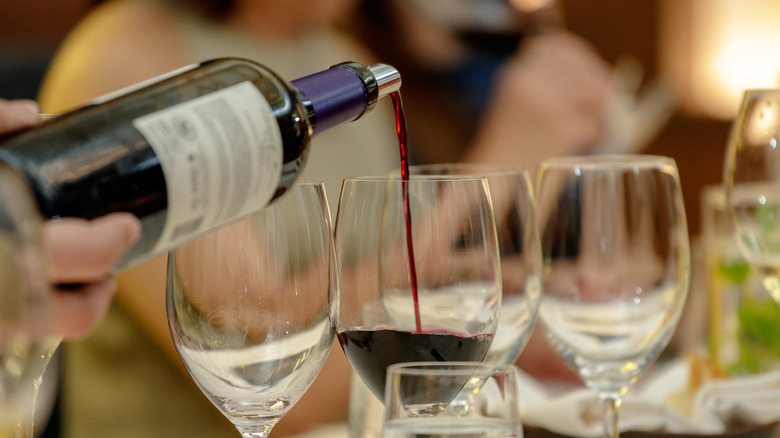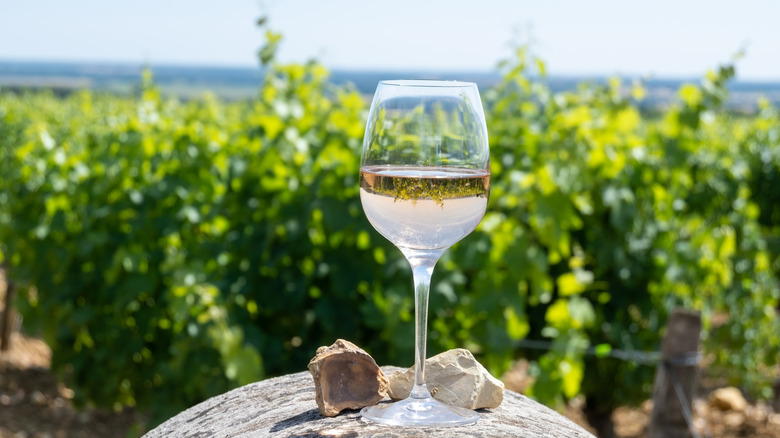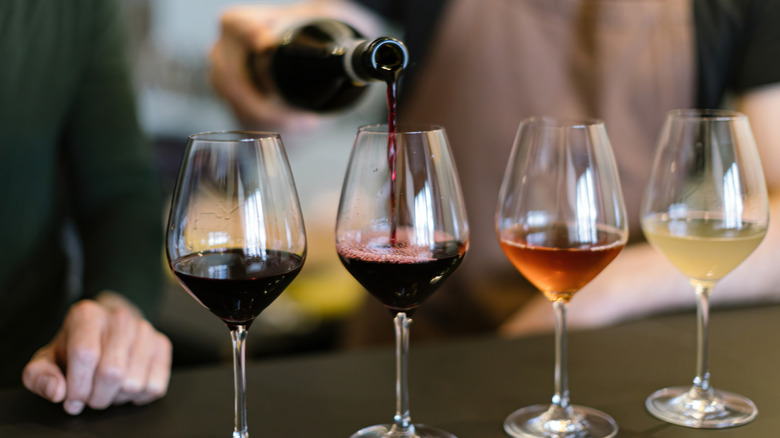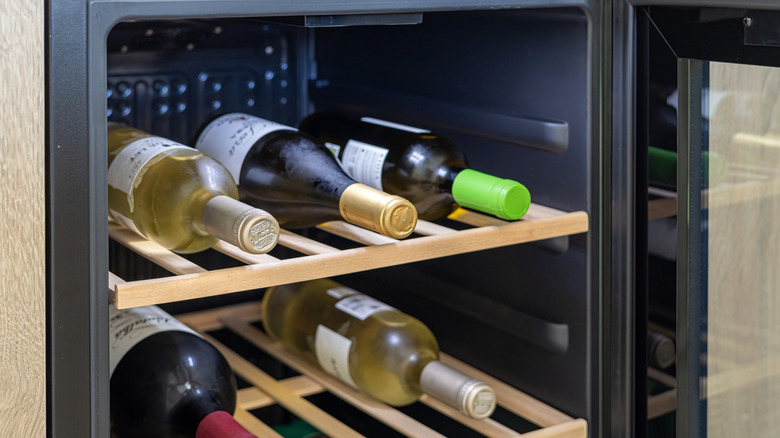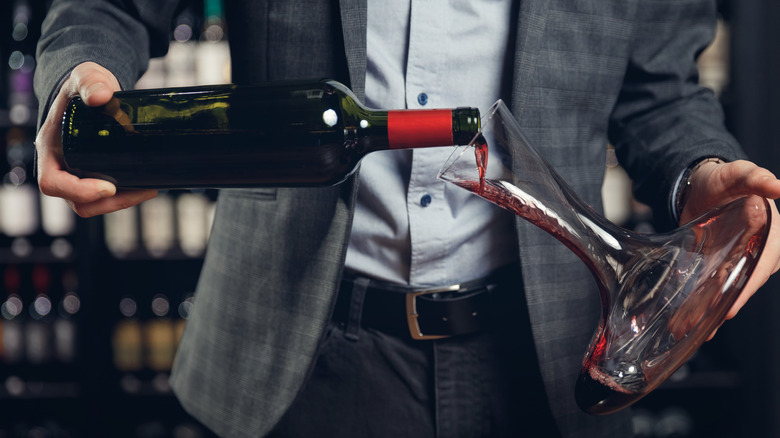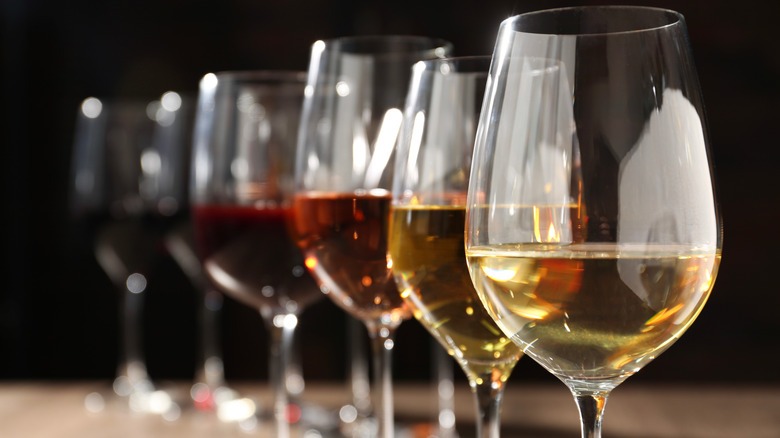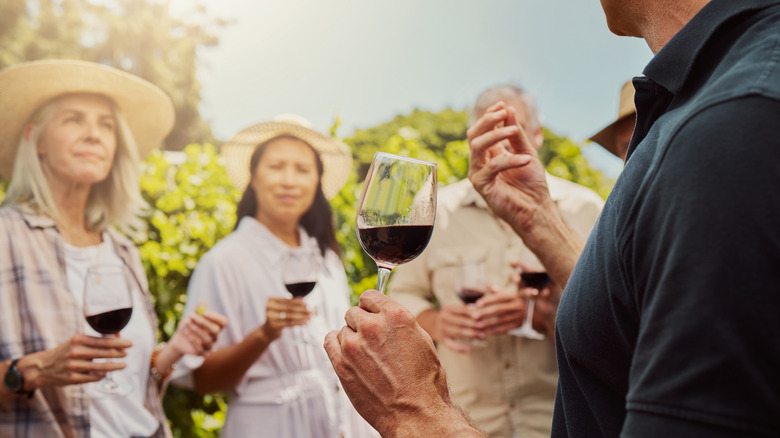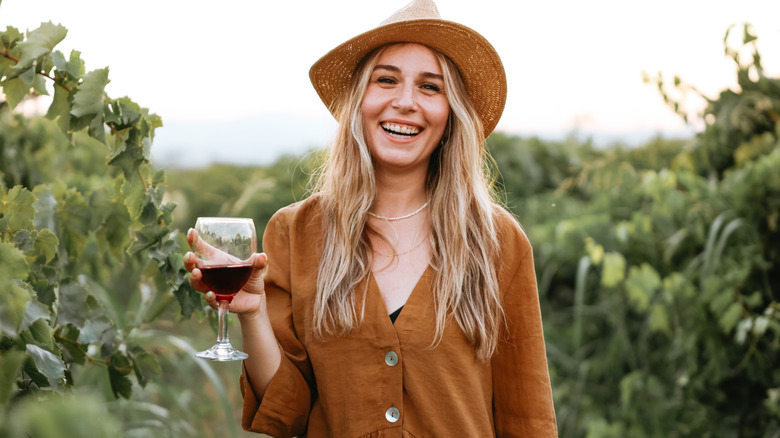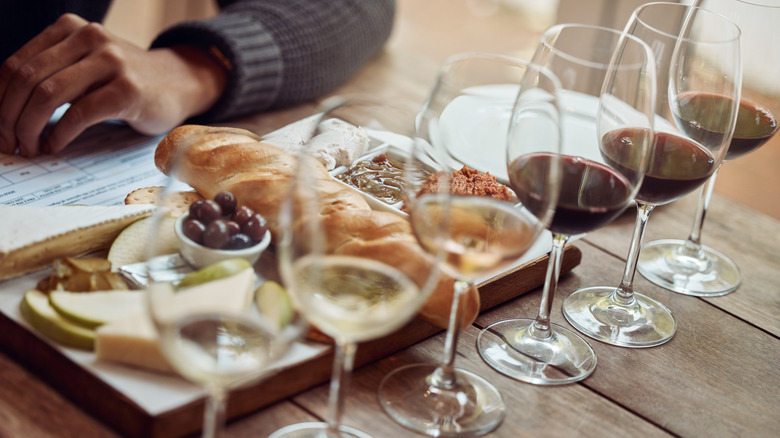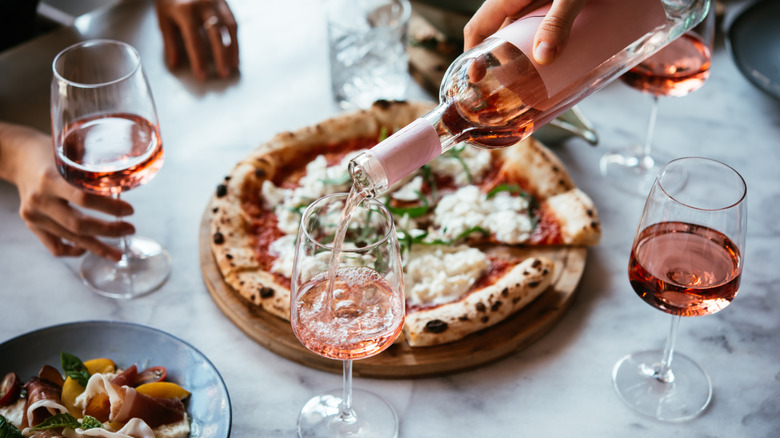12 Common Wine Tasting Mistakes, According To Experts
Even if you love popping open a bottle of wine on the weekends or sipping your favorite bubbly while watching a beloved TV show on a weeknight, most casual wine drinkers can probably agree that actually attending a formal tasting could be intimidating. Wine is so complex, and being around serious enthusiasts who really know their stuff might make you less than thrilled to reveal that your last glass of vino came from a bottle of Trader Joe's Two Buck Chuck.
However, various experts representing wineries and vineyards from around the globe agree: Wine shouldn't be this intimidating, scary thing. You can expand your palate and your mind at the same time, during a formal or even informal wine tasting. In order to really get the most out of such an experience, you'll need to avoid these common mistakes that experts see newbies committing on the regular.
Not trusting your senses
Michelle Lim-Warner is the founder of DCanter, a boutique wine shop in Washington, D.C. She encourages wine tasting participants who may feel a little bit nervous to think of a wine tasting as an experience rather than some test that you're going to either pass or fail. Even if you don't have a lot of background drinking wine, you can still trust your senses without being afraid of being right or wrong.
Lim-Warner explained, "Most of the flavors that we can recognize in wine come from familiar scents and flavors we already know from daily life — like fruits, vegetables, flowers, herbs, or even the smell of a forest or leaves after rain. So, name what you sense to be true, and in doing so, you'll strengthen your confidence and familiarity with flavors in wine."
Ole Thompson, wine director at Esquin Wine & Spirits, said something similar: "You've been trained since childhood to identify and judge flavors, textures and aromas in food." As such, Thompson that when you're thinking about whether or not you like a particular wine, consider all your senses, not just taste. Engage your memory, too, as the wine may remind you of something you've consumed in the past. "Does it taste like just-picked cherries that [are] still a little green or stewed plums in a cake? My first mind-blowing wine experience was tasting an Hermitage — because it tasted like bacon. I didn't know a wine could taste like bacon!"
Ignoring the wine's origins
Trying to pick the right words to use during a wine tasting? If you're still not keen on relying merely on your own senses and memories, you can begin to understand a particular wine often by considering its origins, and whether the wine came from a cool or warm climate.
Michelle Lim-Warner explained, "Cool-climate wines often have higher acidity and more subtle fruit notes — think crisp and refreshing — and, yes, even red wines! Warm-climate wines tend to be fuller and fruitier, with softer acidity. This all comes down to sunshine: The more sun a grape gets, the more sugar (and therefore fruitiness) it develops."
Additionally, along the lines of paying careful attention to a wine's origins, don't be tripped up by thinking that, just because you know a certain varietal of wine well, that the same Cabernet Sauvignon or Chardonnay that you drink from Napa or Sonoma is going to taste the exact same, everywhere in the world.
According to Todd Myers, owner of Rhumb Line Vineyard in Arizona, "Wine regions develop their identity based on what grows best in their specific climate and soil. ... When visiting a new wine region, approach it with curiosity rather than comparison. Ask what grapes grow exceptionally well in the area and why. ... The adventure of wine tasting is exploring these regional differences, not finding replicas of what you already know."
Moving too quickly between wines
During a standard wine tasting, you're going to taste at least four wines, sometimes maybe more. However, don't rush through the process (even if you can typically make quick work of a glass or two). When you lack patience, you could find that you're judging the wines without really experiencing them. So, in addition to not rushing through the wines themselves, also don't rush to pick your favorite of the bunch.
Ildikó Götz, Hungarian wine ambassador and marketing and export director of Götz Winery, mentioned this newbie mistake in relation to wines sourced from Hungary's Tokaj Wine Region. "Tokaj wines — especially Furmint and Aszú — need time to unfold," she said. "Many tasters judge them too hastily, without allowing the wine to breathe and open up. Tokaj wines reveal their aromas layer by layer, so it's worth slowing down and observing how they evolve in the glass."
Georgio Meletiou, resident sommelier at Spier Hotel and Wine Farm in South Africa, similarly noted, "Guests decide too soon which wine they 'like' without revisiting it after the palate adjusts or after another sip. ... Our wines are like people — they open up as you spend time with them... Come back to the wine after [you've] tasted the next."
Taking a wine tasting too seriously
If you think of wine as only something to be enjoyed in formal settings, something that only fancy people drink, then you're probably going to approach your next wine tasting a little too seriously. It's time to drop those expectations and really just have fun with it. A wine tasting doesn't have to be any more formal than a whiskey tasting, for example, or even just enjoying a flight of beers at your favorite craft brewery. Of course, the environment wherein you taste your wine could make this casual approach a little difficult. So choose your wine tasting setting with care.
The Takeout received some sound input on the matter from Theo Rutherford, director of wine and spirits education for Deutsch Family Wine & Spirits, parent company of Josh Cellars. As Ruthherford told us, "A common mistake about wine tastings is that they need to be formal or serious. In reality, a great tasting should feel approachable and conversational. Whether you're at a restaurant with a sommelier or sitting at the park with friends tasting different bottles, the goal is to explore, discover what you enjoy, and develop an appreciation for winemaking. It doesn't need to follow a strict structure — it should be about curiosity and connection."
Tasting wine at the wrong temperature
You've probably heard that red wine needs to be served at about room temperature and other wines need to be served refrigerated, but if you're hosting an informal wine tasting at home, are you getting these temperatures exactly right? Possibly not and, in fact, these accepted rules over wine temps could even be wrong.
"A common mistake beginners make when tasting wine is serving red wines too warm. Wine should be cooled to the appropriate temperature so you can fully appreciate its aroma and flavors. For Riunite Lambrusco, we even recommend serving it over ice to enjoy its crisp, refreshing, and slightly sweet profile," said Elena Lottici, export manager at Riunite.
Alejandro Rubio, an accomplished sommelier from Chihuahua, Mexico, likewise noted that if you serve a full-bodied red at too warm a temperature, it can come across as too heavy, tannic, or alcoholic. In contrast, a white wine or rose that's too cold may lose some of its nuance and come across as a bit plain.
Andrea Card, senior winemaker at Francis Ford Coppola Winery concurred, adding, "For the best experience, red wines should be served around 60–65°F and whites closer to 45–50°F, but of course rules are meant to be broken, as chilled reds can also be lovely!"
Not aerating the wine appropriately
According to Elena Lottici, "Another mistake is swirling and sniffing the wine too lightly. Beginners often don't aerate the wine enough in the glass, which can limit their ability to detect its aromas and fully experience the complexity."
Don't be thrown off by the term "aerate," if you're unfamiliar with it. This simply refers to exposing the spirit to a certain amount of oxygen, which helps it show off its best features. You can achieve that in a handful of ways.
As Lottici mentions, you can allow the wine to aerate in the glass, which simply includes pouring the wine into the glass, swirling it, and letting it breathe for an appropriate amount of time. You can also decant the wine before tasting, or use a specially designed aerator gadget (though professional sommeliers can be rather picky about these products). Some wine drinkers will even take a more MacGyver-esque approach to the process, tossing their wine into a blender for 30 seconds, or pouring the wine between two pitchers, over and over again, over a few minutes.
Overlooking aromatics
It's not just the taste of the wine that you'll want to pay attention to. Aromatics are just as important a part of the wine tasting process. "Many first-time wine tasters immediately sip without taking a moment to smell the wine first. This skips one of the most important parts of the tasting experience. Our sense of smell is deeply connected to taste, and the aromatic profile of a wine tells you so much about what you're about to experience," said Todd Myers.
Myers recommends swirling the wine in the glass and then inhaling before taking that first sip. Note the aromas you detect, whether they're fruity, floral, earthy, or spicy. Doing so can prepare your palate for the tasting experience ahead, as well as turn your wine tasting into just that: an experience.
Georgio Meletiou agreed, saying, "Slow the moment down. At Spier we like to take a breath with each wine — it's part of connecting to the care and time that went into it."
Tasting too many wines in one sitting
How many types of vino should you sample at one time? Alejandro Rubio said that the sweet spot for a wine tasting is four, six at maximum. When you try too many selections in one sitting, you end up overwhelming both your palate and your ability to actually judge the wines appropriately. As for picking specific wines, Rubio further recommended choosing a theme, such as four young white varietals or one varietal but sourced from different wine-growing regions. This keeps the experience structured and leaves you more likely to actually remember what you tasted.
At LaBelle Winery in New Hampshire, tasting room and hospitality manager Maureen Kelly noted the same issue, adding, "Although I've heard many guests say that 'you can never taste too much wine,' your senses become dull after too many different samples. Stick to shorter tastings to maintain a strong palate."
Not asking questions during a wine tasting
If you're attending a wine tasting led by a professional sommelier or tasting room manager, never be afraid to ask questions. That's how you learn, after all.
"Although the wine industry appears intimidating and sometimes snobby, your wine guide is happy to help you," assured Maureen Kelly. "Ask questions to increase your wine knowledge."
Todd Myers also weighed in on the matter, remarking, "Tasting room personnel are passionate about their wines and eager to share their knowledge. They're there to guide you, answer questions, and help you discover wines you'll love. There are no 'dumb questions' in a tasting room."
If you're just not sure what to ask or how to get a conversation started with the tasting room personnel, Myers offered a few suggestions. Ask the pros about their growing process specifically, to start. Why do certain grapes grow best in the region? How do the climate and soil impact the grape growing? What wine would they recommend based on your own preferences? When they do recommend a wine, ask about the story behind it and what food you can pair with it in the future.
Holding the wine glass incorrectly
According to Maureen Kelly, holding your wine glass by the bowl is one of the biggest mistakes you can make during a wine tasting, as your body heat will warm up the liquid. As you may recall, the temperature is a really big deal when wine tasting. Kelly recommends always holding your wine glass by the stem, to avoid this issue and, "to follow this point," she said, "using a stemless glass is also a common mistake."
However, not all wine glasses are the same, even if they do have a stem. Generally, they are separated into red wine glasses and white wine glasses, with the former featuring larger, more rounded bowls and wider openings. This allows for greater aeration, as red wine typically needs more aeration than white wines. Likewise, even if both types of wine glasses have stems, they may have stems of different lengths. White wine glasses have longer stems, so you can keep your toasty fingers away from the wine (remember that white wine is primarily served at a colder temperature than red wine).
Skewing your senses before a wine tasting
Coming into a wine tasting with your senses working at their best is important to getting the most out of the experience. So, just like wearing anything that can interfere with your senses is one of the biggest mistakes you can make when attending a whiskey tasting, so is wearing strong scents to a wine tasting. Maureen Kelly noted that fragrances can interfere specifically with your ability to truly take in the wine's aromas. Furthermore, she said, you can inadvertently skew your sense of taste, too. If you eat flavorful foods or chew on some minty gum ahead of your tasting, you won't exactly have a neutral palate going into the tasting.
Eléonore Latour, vice president of Maison Louis Latour, likewise commented on this common problem, saying, "Avoid [a] tasting immediately after strong foods or drinks (such as spicy, salty, or bitter food or drink, where flavors are concentrated and powerful), and cleanse your palate between wines with bread or water. This ensures your taste buds can pick up on the delicate notes in each wine."
Pairing your wine tasting with the wrong food
Who wouldn't want to combine a wine with some scrumptious snacks? However, before you begin putting together a charcuterie board, really think about what would pair best with the various beverages. As Andrea Card said, "What you eat can dramatically alter how a wine tastes. Tasting on an empty stomach or pairing with highly sweet, spicy, or acidic foods can distort the wine's true character. Instead, choose neutral bites such as crackers, bread, or mild cheese between tastings to keep your palate balanced."
Of course, if you're not necessarily worried about actually tasting the wine's true character and really want to have a good meal with it, you can be a little more lax in your pairings (some sommeliers will contest the validity of food-wine pairings anyway). So, go ahead and eat a spicy food with your wine — just maybe pick a high-acid wine to go with it, as the highly acidic wine, like a Pinot Noir, will supposedly make your mouth water while you eat, cleansing your palate between bites and sips. Pairing wine with smoked meats? Pick a fruit-forward varietal like a fruity Syrah. Or, why not drink wine with Doritos? Reisling is apparently the perfect pick for this scenario.
